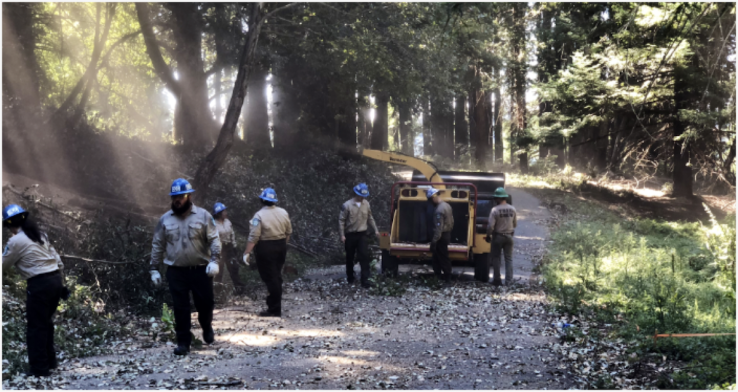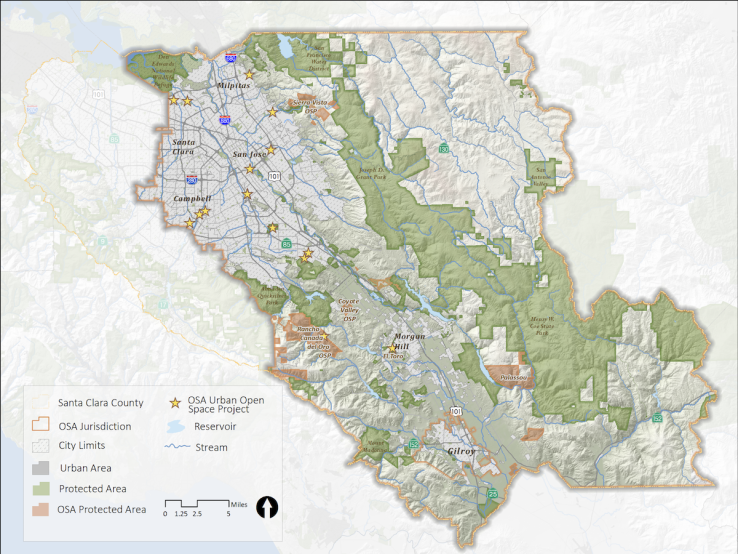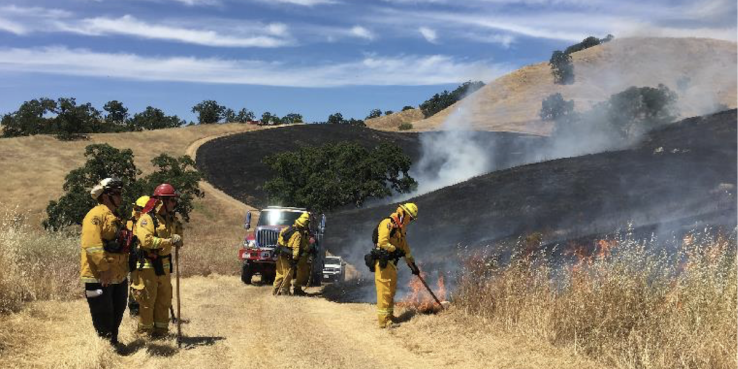2018 was the deadliest and most destructive fire season in California history. Over 20,000 structures were destroyed and 98 people killed in a fire season that extended into late fall. Climate change will only accelerate this dangerous trend: the combination of hotter, drier weather, large areas of dense vegetation and larger populations living in fire zones poses a greater risk of wildfires starting and spreading in future.
What is Santa Clara County doing to prepare for the increase in fire risk posed by a changing climate? At a recent SPUR forum in San Jose, Deputy Chief Jason Falarski of the Santa Clara County Fire Department, Derek Neumann of the Santa Clara Valley Open Space Authority and Michael Rhoades of the Santa Clara County Parks Department discussed how they are working together to prevent a fire event from devastating the South Bay.

Reduce Fuel Through Maintenance and Prescribed Burning
One of the most significant strategies is to reduce the amount of fuel (vegetation) in open spaces. In the past, fires burned off dead tree matter and chaparral every 20 to 50 years, but since the Bay Area has become more densely settled, very few fires have been allowed to burn in this way. The result is fires that burn hotter and faster when they do ignite.
The county’s fire prevention efforts include creating fire breaks in strategic locations in parkland and open space and removing brush in key corridors like roadways, where car fires can spread easily. In addition, they are removing invasive species, which are more flammable than native species. The County Parks Department, for example, has applied for a $500,000 grant from the cap-and-trade fund to remove and dispose of 30 acres of mature eucalyptus in the county.
Prescribed or controlled burns are another critical tool for preventing fire and increasing the health of ranch land and open space. County organizations conduct a number of prescribed burns. These sometimes face objections from homeowners and park visitors who are alarmed by the sight and smell of smoke and concerns over air quality. A San Francisco Bay Area Prescribed Fire Council has recently been convened to allow professionals and local landowners to share expertise and carry out more prescribed burns. Key areas of focus for this group will be educating homeowners about the importance of prescribed burns and streamlining the California Environmental Quality Review (CEQA) guidelines to make it easier to conduct controlled burns in future.
Work Directly With Homeowners in the Wildland Urban Interface
The wildland-urban interface (WUI) is the area where houses meet undeveloped land that includes vegetation. There are over 14,000 homes in unincorporated WUI areas across the county, and agencies are working with homeowners to develop emergency plans for fire events and reduce the risk of fire spreading. New construction in unincorporated areas is subject to the stringent state building code and must be reviewed by the fire marshall’s office, but older properties can be a significant source of fuel for fires.
The Santa Clara County Fire Department works directly with communities in these spaces, conducting inspections for fire hazards and developing mitigation plans. The department will launch a series of community workshops in 2019 called Ready, Set, Go to encourage homeowners in the WUI to prepare a wildfire action plan, including escape routes and preparations for large animal rescue. The workshops will also emphasize fire readiness through better spacing of vegetation, clearing noxious weeds from around houses, and replacing shingle or wood roofs with more fire-resistant materials. Grants are available to homeowners to make these changes.
Protect Open Spaces From Development
Santa Clara County is surrounded by a mix of parks and open space that have historically formed an “emerald necklace” around the county. These open spaces serve as buffers where firefighters can suppress or slow fires down, preventing them from surging between developed areas.
For example, agricultural and ranch land, including that on the valley floor, acts as a fire break if properly maintained through animal grazing that reduces fuel build-up. The county’s many parks are also strategically located to control the spread of fire, but they require active land management with this in mind, including some of the prescribed burn strategies outlined above.

Collaborate and Share Resources Among Organizations
In addition to the Prescribed Fire Council, a number of organizations exist to facilitate collaboration at the community and county level. The Santa Clara County Firesafe Council is focused on fuel reduction, planning and outreach, with a membership that includes fire agencies, open space managers, city governments and private citizens. The council’s county-wide Community Wildfire Protection Plan supports communities to organize prevention projects and initiatives at the local level.
The collaboration extends to the state level, where state-funded California Mutual Aid allows counties to send resources where they’re most needed during fires. GIS weather simulators and fire-detection cameras allow agencies to predict demand and distribute resources where needed in advance. CalFire also operates at the state level and is in the process of replacing its entire helicopter fleet to address the critical early stage, where initial response has been overextended in recent years with multiple simultaneous wildfires.
With wildfires more likely in the future, fire prevention and response is the responsibility not just of countywide organizations but of individuals. Members of the public are encouraged to comment on the Community Wildfire Protection Plan and practice fire safety and preparedness. We also recommend opting in to AlertSCC, a county-wide alert system for emergency events.
